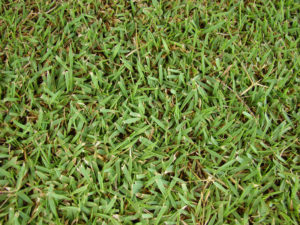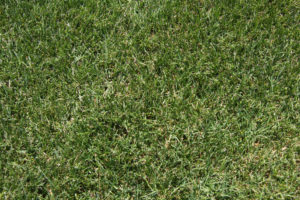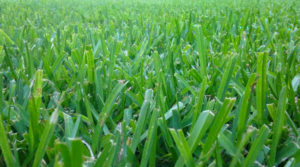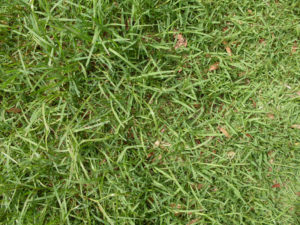Texas Lawn Care Guide
The #1 DIY Lawn Care Resource for TexansBest Grass Types
Buffalo Grass
Buffalo Grass is a Texas native turf grass named for its history in feeding wild buffalo roaming around the United States. Today, it serves as a premium, wildlife-friendly grass for lawns in Texas. This aggressive grass competes heavily with weeds during times of drought limiting the need for any herbicides. Buffalo grass, compared to other grasses grown in Texas, is resilient to a lack of water. Experts recommend watering only every 21-45 days, making this grass the most economically sound grass to grow in Texas. This grass is best grown in central, south, west and North Texas, but it does not do well in sandy soils in East Texas or coastal Texas.
Bermuda Grass
Bermuda grass is a warm-season grass that is tolerant of heat, drought, and traffic but requires regular maintenance. It is often grown in southern states and thrives in Texas. This grass grows very quickly, giving to both it’s high maintenance and traffic tolerance. Experts recommend mowing and watering the lawn up to two times a week during peak growing season. Bermuda grass is drought tolerant, but in these times it will go dormant and leave the lawn less than appealing.
Centipede Grass
Centipede grass is a warm-season grass favorite for its extremely low maintenance requirements, meaning it will grow almost anywhere with little or no treatments. This grass is equipped with a high heat tolerance and moderate shade tolerance. Centipede grass is sensitive to cold weather like most warm-season grasses. Its shallow roots do not allow for much drought resistance and its small traffic resistance makes it susceptible to bare spots and weeds.
St. Augustine
St. Augustine is a warm-season grass with a medium to dark green hue. It is the most shade tolerant of all the warm season grasses which makes it a good grass for those with trees and little sun exposure. The grass is also known for its heat and mild drought resistance. Augustine can handle light traffic and will compete against weeds, more so than some other warm-season grasses. Some homeowners with this grass have noticed a vulnerability to different pests that have posed a problem for gardeners.
Lawn Mowing
Mow on a High Setting and Sharpen Blades
It is important in Texas to make sure your mower is set at a high setting, especially during summer. This will take the stress away from your lawn by shading the soil and preventing weeds to grow. A good rule of thumb for cutting the grass is never cutting more than a third of the blade. Depending on the type of grass you have, growth and ideal height will vary. It will also add to the lawns health if you sharpen the blades on the lawnmower. Slicing the grass stems with a clean cut is much healthier than tearing them. Experts recommend sharpening the blades twice during the mowing season between March and early October.
Mow When it is Dry
Mowing the lawn when it is damp can lead to a very unattractive lawn. Chlorophyll in the grass is more likely to bleed from the stalks when it is wet and can stain nearby concrete. The lawnmower itself can even damage the lawn with its tread and can leave wheel indentations. The best advice is to mow the lawn when it is dry. This will leave the lawn looking crisp and you won’t have to worry about raking in the clippings like you would if you insisted on mowing when damp.
Leave Leftover Clippings
Excess clippings leftover from mowing the lawn can be great in terms of lawn care. These act as a natural fertilizer for the lawn. Not only will it save time, but it will save about 8 bags of trash a month from getting placed in a landfill. As long as the lawn is up to date in aeration and raking, the grass clippings will not add to thatch build up. If the clippings are gathered in one place, raking them around will help let the lawn breath.
Core Aeration
Core aeration is the process of removing several cores of soil and thatch from the lawn. It may seem odd or destructive, but it can actually be the difference between a normal lawn and an extraordinary lawn. Over time the soil in a lawn will naturally become compacted and will not allow nutrients and water to reach down to the roots. Through core aeration, the lawn will have a chance to breathe and allow nutrients and water to reach important segments of the soil.
The best time for Core Aeration
Texas lawns usually operate with warm-season grasses, so core aeration should take place during late spring or early summer. For cool-season grasses, core aeration should take place during fall. Usually experts recommend aerating once a year, however for high traffic lawns, for those with kids or pets, aerating twice a year may be necessary.
Overseeding
Overseeding is an important task for Texan homeowners that ensures a bright green lawn year round. During cool seasons, warm-season grasses will turn brown in their dormancy. Ryegrass is a cool-season grass with a fast-growing capability. Overseeding with ryegrass just as fall emerges will allow your lawn to flourish from October to Spring season. As ryegrass takes to a lawn very easily, there is not a lot of work that goes into overseeding. After mowing your permanent lawn, sow the rye seed at the packaging recommendations per square foot. Water the lawn lightly every day or two until the seeds germinate (10-12 days). After the second mowing, you can fertilize the grass. Ryegrass will adapt to mowing heights recommended for your permanent grass type.
Popular Grass Types for Texas Lawns
Warm-Season Grasses
Bermudagrass
Bermudagrass is the most popular grass type in Texas. It’s a warm-season grass that is exceptionally resilient against pests and disease. Bermudagrass grows thicker the more it is mowed, creating a carpet-like effect in the front or backyard. It also has a higher traffic tolerance than most turf grasses, making Bermudagrass ideal for the families who have children and pets.
Water requirements: 1/2 inch or less per week to stay green
Mowing height: 1.5 inches
Sun requirements: Full sun, little to no shade
Pro tip: Mow when or at 2.25 inches
St. Augustinegrass
St. Augustinegrass, specifically Raleigh St. Augustinegrass, is arguably the second most popular grass type in Texas. Though wildly popular in Texas, it is susceptible to brown patch disease and chinch bugs. It also doesn’t tolerate heavy foot traffic very well. However, it’s fairly cheap to grow a St. Augustine lawn and doesn’t require a lot of maintenance. St. Augustinegrass is a good summer lawn but will become brown and brittle in the winter once it becomes dormant.
Water requirements: Needs 0.75 inches per week during peak growth, 0.50 inches per 2-3 weeks in dormancy
Mowing height: 3-4 inches
Sun requirements: Full sun, little to no shade
Pro tip: Raleigh St. Augustinegrass has the best cold tolerance of all warm-season grasses
Buffalograss
Buffalograss is a native turfgrass to Texas. It’s the most popular in West Texas where it grows wild along the highways. Buffalograss is easy to maintain and doesn’t require a lot of upkeep and TLC. It has low disease potential, and low mowing and fertilization requirements. Buffalograss goes dormant in early fall and tolerates drought very well. It has been known to be susceptible to weeds in areas outside of Texas. However, West Texas residents typically don’t experience these problems.
Water requirements: Needs 1 inch per month to stay green during peak growing season
Mowing height: 5-6 inches
Sun requirements: Very poor shade tolerance
Pro tip: Buffalograss is unique from other grass types because it has male (staminate) and female (pistillate) flowers on separate inflorescences
Zoysiagrass

Zoysiagrass is one of the most diverse lawn grasses available and grows pretty much everywhere that Bermudagrass grows in Texas. Zoysiagrass is the most shade tolerant out of all the other grasses on our list. Making it ideal for East Texas lawns where the shade is abundant. Though it is susceptible to Rust Fungus in the fall, it’s a fairly low maintenance grass that’s great for outdoor living. Zoysiagrass typically prefers a reel mower (and so does the air around you), however, a rotary mower will work just fine.
Water requirements: 0.75 inches to stay green during the growing season, 0.50 inches to sustain
Mowing height: 2 inches
Sun requirements: Fair shade tolerance
Pro tip: Mow when at or before 3 inches



